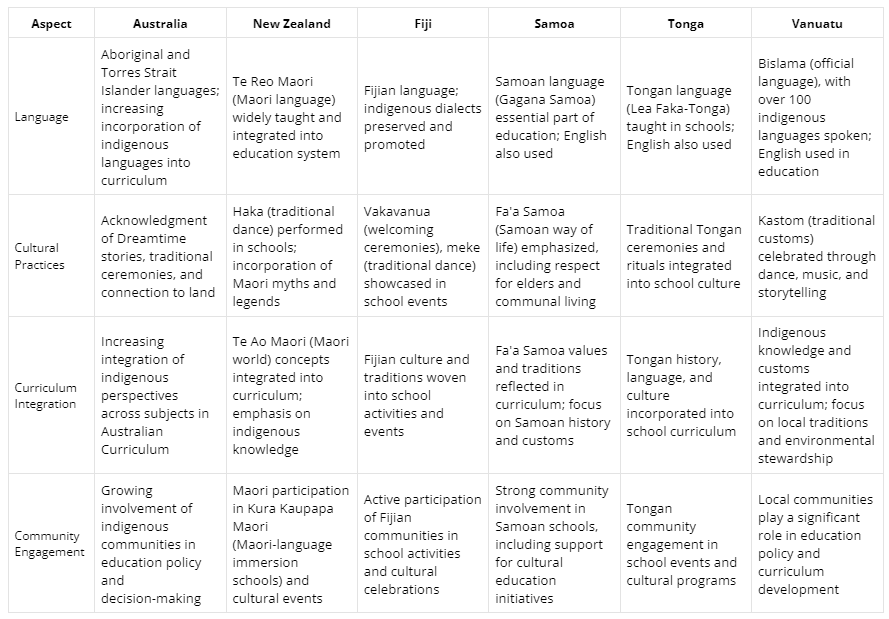Indigenous Wisdom in Australian and South Pacific Classrooms
In the classrooms of Australia and the South Pacific, a rich tapestry of Indigenous wisdom weaves its way into the educational landscape. From the Dreamtime stories of First Nations Peoples to the navigational prowess of Polynesian voyagers, the Indigenous cultures of these regions offer invaluable insights that enrich both academic learning and cultural understanding.
Incorporating Indigenous wisdom into classrooms fosters a sense of cultural connection among students. By engaging with the stories, practices, and perspectives of Indigenous peoples, students gain a deeper appreciation for the diverse heritage of their own communities and those around them. This connection not only enriches their academic pursuits but also promotes empathy, respect, and solidarity across cultural boundaries.
For Indigenous students, seeing their cultures reflected in the classroom validates their identities and instills pride in their heritage. Incorporating Indigenous perspectives affirms the importance of diverse cultural narratives and provides a platform for Indigenous voices to be heard and respected.
Diverse Pedagogies and Shared Goals
The education systems of Australia and the South Pacific nations exhibit remarkable diversity, reflecting the unique cultural, historical, and social contexts of each country.
In Australia, the curriculum is governed by national standards known as the Australian Curriculum, which outlines learning objectives and content across various subject areas. Emphasis is placed on core subjects such as English, mathematics, and science, with an increasing recognition of the importance of incorporating Indigenous perspectives and cultural knowledge into the curriculum.
Conversely, in countries like Fiji, Samoa, and Tonga, education is deeply rooted in communal values and traditions. Learning often takes place within the context of extended family networks and community gatherings, where elders impart wisdom and knowledge through oral storytelling and practical demonstrations. While formal education systems exist, they are often supplemented by informal modes of learning that emphasise the transmission of cultural heritage and values. View a comprehensive comparison table of Indigenous educations within classrooms.

Indigenous Cultures: Guardians of Knowledge and Challenges and Opportunities
Despite the richness of Indigenous cultures and educational traditions, both Australia and the South Pacific face challenges in ensuring equitable access to quality education for all. In Australia, disparities in educational outcomes persist for Indigenous students, highlighting the need for culturally responsive teaching practices and greater support for Indigenous-led education initiatives.
In the South Pacific, limited resources and infrastructure pose significant barriers to educational advancement, particularly in remote and rural communities. However, there are also opportunities for collaboration and knowledge exchange between Australia and its South Pacific neighbours, leveraging shared experiences and expertise to enhance educational outcomes for Indigenous and non-Indigenous students alike.
Building Bridges for the Future
As we navigate the complexities of comparative education systems in Australia and the South Pacific, it is essential to recognise the interconnectedness of our educational landscapes. By embracing Indigenous perspectives, fostering cultural exchange, and prioritising inclusive and equitable education practices, we can build bridges across cultures and create a more vibrant and resilient future for all.
References:
- “History, Culture, and Indigenous Education in the Pacific Islands.” In Indigenous Education: Language, Culture, and Identity. W. J. Jacob, S. Y. Cheng, and M. K. Porter (eds.), pp. 281-299. Springer, Dordrecht, 2015First Nations Education Steering Committee (FNESC)
- Australian Government. (n.d.). National agreement. Closing the Gap. Retrieved from https://www.closingthegap.gov.au/national-agreement
- ArtsLive. (n.d.). Six tips for First Nations culture. Retrieved from https://www.artslive.com/news/six-tips-for-first-nations-culture/
- Hughes, P. (1997). Indigenous education in Australia and New Zealand. Australian Association for Research in Education. Retrieved from https://www.aare.edu.au/data/publications/1997/hughp518.pdf
- Painaustralia. (n.d.). 8 Aboriginal ways of learning factsheet. Retrieved from https://www.painaustralia.org.au/static/uploads/files/8-aboriginal-ways-of-learning-factsheet2-wfklwmnralub.pdf
- United Nations Framework Convention on Climate Change. (n.d.). Pacific. Local Communities and Indigenous Peoples Platform. Retrieved from https://lcipp.unfccc.int/about-lcipp/un-indigenous-sociocultural-regions/pacific
- Victoria State Government. (n.d.). Koorie culture. Department of Education and Training. Retrieved from https://www.education.vic.gov.au/school/teachers/teachingresources/multicultural/Pages/koorieculture.aspx
- Wikipedia contributors. (n.d.). Indigenous peoples of Oceania. In Wikipedia, The Free Encyclopedia. Retrieved from https://en.wikipedia.org/wiki/Indigenous_peoples_of_Oceania
